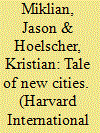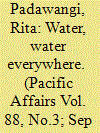| Srl | Item |
| 1 |
ID:
132532


|
|
|
|
|
| Publication |
2014.
|
| Summary/Abstract |
The global shift from rural to urban living will be the most important demographic transformation of the 21st century. All great shifts create the opportunity for great fortunes, especially for those with audacious visions who are positioned to capitalize on them. Indian industrialist Ajit Gulabchand runs Hindustan Construction Company (HCC), which is responsible for some of the country's most iconic infrastructure projects. In what might be the single biggest bet in the history of Indian real estate, Gulabchand has staked HCC's future - and his own family fortune - on a cluster of five planned cities perched along artificial fjords about four hours east of Mumbai. He calls it Lavasa. 300 million people are projected to move into India's already overcrowded cities over the next quarter-century. Lavasa is Gulabchand's US$6 billion dollar attempt to capitalize on this demographic shift - and turn a profit in the process. He even modeled Dasve, the first of Lavasa's five cities, after Portofino on the Italian Riviera. Lavasa's sales team speaks of a "stirring adventure", complete with French lessons and rock climbing, for the 300,000 residents that it hopes to attract. With Indian cities feeling increasingly like pressure cookers, Lavasa's promise of clean air, sidewalks, and personal space attracted huge investments.
|
|
|
|
|
|
|
|
|
|
|
|
|
|
|
|
| 2 |
ID:
140390


|
|
|
|
|
| Summary/Abstract |
Jakarta has entered an era of chronic flooding that is annually affecting tens of thousands of people, most of whom are crowded into low-income neighbourhoods in flood-prone areas of the city. As the greater Jakarta mega-urban region—Jabodetabek—approaches the 30 million population mark and the sources of flooding become ever more complex through combinations of global climate change and human transformations of the urban landscape, government responses to flooding pursued primarily through canal improvements fall further behind rising flood risks. Years of field observation, archival and ethnographic research are brought together in a political ecology framework to answer key questions concerning how government responses to flooding continue without significant participation of affected residents who are being compelled to relocate when floods occur. issue_image_88_3_PadawangiHow do urban development processes in Jakarta contribute to chronic flooding? How does flooding arise from and further generate compound disasters that cascade through Jakarta’s expanding mega-urban region? What is the potential for neighbourhoods and communities to collaboratively respond through socially and environmentally meaningful initiatives and activities to address chronic flooding? Floods, urban land use changes, spatial marginalization and community mobilization open new political dynamics and possibilities for addressing floods in ways that also assist neighbourhoods to gain resilience. The urgency of floods as problems to be solved is often interpreted as a need for immediate solutions, but flood-resilient communities are rooted in gains in resilience in non-emergency times by expanding rights to live in the city, to build houses and create vernacular communities by and for people
|
|
|
|
|
|
|
|
|
|
|
|
|
|
|
|